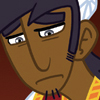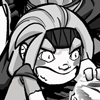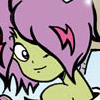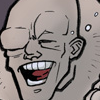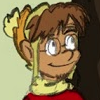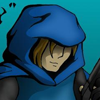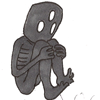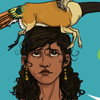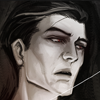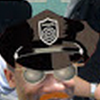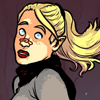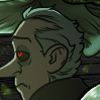Category Archives: adventure webcomic
WCO.243: Parallax

Back in the 80’s, I was a nerdy preteen who got heavily into computer programming. None of this complex JavaScript, C++, or assembly language stuff. Just BASIC, which is basically computer programming for babies. Eventually I’d get good enough at it that I’d create my own simple Super Mario-inspired platformer.
One of the earliest games I’d programmed, though, was some code available in a library book. It was a text based adventure game. I’ve never played Zork, but through cultural osmosis I can tell you it’s something like that. You could type things like “Go West” and get stunning replies like “You can’t go west.” I suppose I have no one to blame for these geographical limitations since I’m the guy who technically programmed them in.
Anyway, this particular game went something like this. Your Uncle Simon has just passed away. One day, you receive a mysterious letter in the mail. After doing some fetch-quest things, you end up activating a portal to another, fantastical world.
Mysterious packages seem de rigeur im adventure settings. It’s a somewhat humble way to receive a ticket to adventure without necessarily having the ambition to follow the hero’s path. Greatness is basically thrust upon you wrapped neatly in brown paper. It’s a gift that drives the hero of Falke’s webcomic, the superhero adventure Parallax.
WCO.242: Never Satisfied

People, let me make a stark confession here. I have no idea what’s cool, especially with regards to webcomics. I am a total poser. I pretend like a cool person with some semblance of authority, but the reality is that I am a fraud. I crave the desire to have people look up to me, despite knowing zilch about how to make webcomics or how to judge them by their quality.
These characteristics place me on roughly the same level as Lucy of Never Satisfied. Apparently it’s got quite a few fans. One such is Comics Alliance, which awarded this title as the Best New Webcomic of 2015. “A delightful webcomic by Taylor Robin, with sharp artwork, artful storytelling, and a colorful, diverse cast of characters” raves the revered comic website. Shamefully, I’d never heard of this comic before, but, you know, I’ve already explained my poser credentials.
WCO#239: Dresden Codak

Aaron Diaz’s Dresden Codak is a strange creature. It debuted back in 2005, back when webcomics were developing a reputation as the sophisticated alternative to their comic strip brethren. xkcd launched in the same year, and A Lesson Is Learned But The Damage Is Irreversible not long before that. Perry Bible Fellowship was starting to gain a strong following. At the core of these comics as a brainy just-out-of-college mentality. The gags were still sometimes juvenile, but at its core were concepts and ideas that were smarter and more clever than ones on the Sunday Funnies. Except Marmaduke. That comic is pretty dang subversive.
And all of them, including xkcd sometimes, would surprise you by hitting you with some great looking art. It may be easy to forget, since a lot of art grads now know of webcomics as a great way to expand their portfolio, but aesthetically webcomic art was pretty dire. The medium, after all, was originally conceived as an amateur hobby where some folks got lucky despite the artistic merit, e.g. tons of pixel comics. As a result, comics like Dresden Codak were incredibly eye-catching in comparison.
Typical of early Dresden Codak is a comic like “Li’l Werner.” It’s a one-shot comic with no continuity baggage. Diaz is still experimenting with his art style: this time homaging the black-and-white cross-hatching of Edward Gorey. The strip hinges around a tongue-in-check parody of Aryan physics (the Nazi nationalist scientific movement to discredit Jewish scientists like Albert Einstein). There’s a sharped-toothed Philip Lenard recalling anti-Semitic caricatures, a tiny Heisenberg, and something about “current momentum.” I don’t pretend to know what the heck any of this is about. But it sounds smart and the multiple tiny Heisenbergs is a cute visual gag. It’s a lovely comic to introduce to your local Tesla fan.

WCO #236: Camp Weedonwantcha

I have a startling confession to make: I’m a pretty big fan of the probably cancelled NBC series Siberia. (I was also a fan of The Cape, so maybe I’m just attracted to failure.) Siberia starts off by fooling viewers into thinking that they’re watching a reality show. Contestants are dropped off via helicopter into the forbidding wilderness of northern Russia. Like all reality shows, they start things off with a silly challenge. Race to the cabins! The last two get eliminated! The trappings are familiar to anyone who’s watched TV in the last decade. There’s filmed confessionals to flesh out character personalities, alliances being formed, and mugging for the unseen cameramen.
Show’s true format and statement of intent reveals itself by the end of the first episode, though. One of the contestants is presumed dead. Brutally mutilated. It slowly dawns on the characters (and the viewers) that nothing on the show is as it seems. Slowly but surely, the safety net disappears. The characters arrived in Siberia with the assumption that, no matter what goes wrong, there’s a support team hiding just out of view to deal with the really serious stuff. Like food rations, medical care, or keeping away dangerous animals or people. Scary moments are initially brushed off as just being part of the show. The real horror creeps in when the characters suddenly realize that nobody is in control, and they are all at the mercy of whatever dark, unspoken mysteries lurk just beyond the campgrounds.
The same sense of primal eeriness permeates Katie Rice’s difficult to spell webcomic Camp Weedonwantcha. (“Weedonwantcha” is a play on words: it’s both a parody of camps that takes on Native American names and what Avengers director Joss Whedon says when he wants to pick up chicks.) The encroaching sense of desperation isn’t at the forefront, though. This is primarily a humorous comic about kids having adventures at camp. One that they seem to be unable to leave. And not because the crafts classes are super fun.

WCO #231: MS Paint Adventures: Homestuck (Act 6)

(For the rest of this multi-part review, check out my thoughts on Acts 1-4 and Act 5.)
You’ve got to hand it to Andrew Hussie. They guy seems to go out of his way to be as alienating as possible. Just when it seems like the story’s gaining traction, he’s all, “Nuts to that sh*t. Time to roll with something that makes even less sense.” When MS Paint Adventures: Homestuck started, it bore a lot of similarities with its predecessor, Problem Sleuth, as a parody of an adventure game, complete with confusing inventory systems and glitchy controls. But then, all of the sudden, it became this complex world-building mythology, with multiple planets and a core system of light and darkness anchored by two planets with two moons.
And then Act 5 rolls around. Hussie introduces a bunch of abrasive new characters with orange horns that were so myriad that they seemed impossible to track. Oh yeah, and they’ve got their own alternative world and a complicated system of romance. Clearly, Hussie has disappeared straight up his own butt, right? Well, that maybe so… but the gamble paid off, and Homestuck became more popular than it ever had been before. At least with the costume stores supplying gray facepaint to all the troll cosplayers out there.
When we get to Act 6, then, the question isn’t, “So, what’s Hussie going to do to answer all these puzzles and mysteries?” It becomes more, “What sort of ridiculous bull is Hussie going to make up just to needlessly confuse and deliberately obfuscate the story even further?”
There are drawbacks to being this experimental, though. At some point, the mythology can get too top heavy, and the characters the readers learned to love over the course of the story get lost in the shuffle. Hey, Losties: remember Lost, Season 6? The experimental one that discarded the format, explored all new characters with a sideway universe where the cast had different adventures because they were living in a parallel world?
Me neither.

One Punch Reviews #87: Battlecroc

Battlin’ animals seem all the rage these days. And the more inappropriate, the better. Pokemon probably started the rage, what with its rats and lizards and … um … mimes all bread for battlin’. The trend has spread to webcomics as well. 2012, for example, saw the Eisner Award go to Battlepug, which, as its title suggests, is about a pug that battles. That, of course, is part of its humor. Who expects a pug to battle? They look like sad little children, more likely to be begging for handouts than to be bathed in the blood of war.
And cuddle unassuming animals are once again at the forefront in Bryan Fleming’s Battlecroc. That’s right, thouse friendly long-snouted fellows that Steve Irwin used to pal around with (until his unfortunate demise at the end of the frightening tail of the stingray) are portrayed as unlikely warriors in a world that hoas gone to the birds.
(That’s right. Again with the bird-bashing. Hasn’t the Angry Birds franchise done enough damage by portraying these feathered hacky-sacks as being in a permanent state of utmost surliness?)

WCO #233: Little Guardians

Fantasy is rooted a little bit in actual history. Most of the time, this means the European Middle Ages. Knights in shining armor, kings and queens, towering castles, and legends of dragons and elves. King Arthur stuff. However, there are tons of challenges in setting things at a certain era. As fantasy writer Poul Anderson once elaborated in his essay “On Thud and Blunder,” “Beneath the magic, derring-do, and other glamour, an imaginary world has to work right. In particular, a pre-industrial society, which is what virtually all hf uses for a setting, differs from ours today in countless ways.”
One of the things that writers often do is just ignore the historical nuisances. Don’t worry about people’s hair not looking perfect; just assume that everyone has access to soap, mirrors, and plumbing. Pay no attention that there are no city lights; our heroes can travel by night just as easily as by day. One of the biggest historical running blocks are the roles of women. Joan of Arc aside, women in the Middle Ages were typically not trained to be warriors. It was dudes. But, since in these days it’s not in the writer’s or the reader’s best interest that the adventurers be one big sausage party, fantasy authors tend to either ignore or minimize male chauvinism. Lady warriors just show up dressed in trousers made for men, and the townspeople rarely bat an eye.
The limited opportunities for women, though, is the driving narrative in Ed Cho and Lee Cherolis’ Little Guardians. The story centers around two characters: Subira, an unassuming shopkeeper’s daughter who has great potential, and Idem, an unlucky boy who’s training to be the next Guardian.
One Punch Reviews #86: Girls of Monster Paradise

Welcome, boys and ghouls, to another frighteningly fun edition of the Deadcomic Overlook … um, Hotel! Ha ha ha ha ha! This is your ever fiendish host, El Satan, bringing you another chilling review of …
Wait.
Is it November already?
…
Well, pilgrim, get ready to feast on another review. This time we’ll be looking at a little giblet of a comic called Girls of Monster Paradise by Stephanie Gladden. Will this webcomic leave you feeling thankful, or will it be turkey terrible?
















